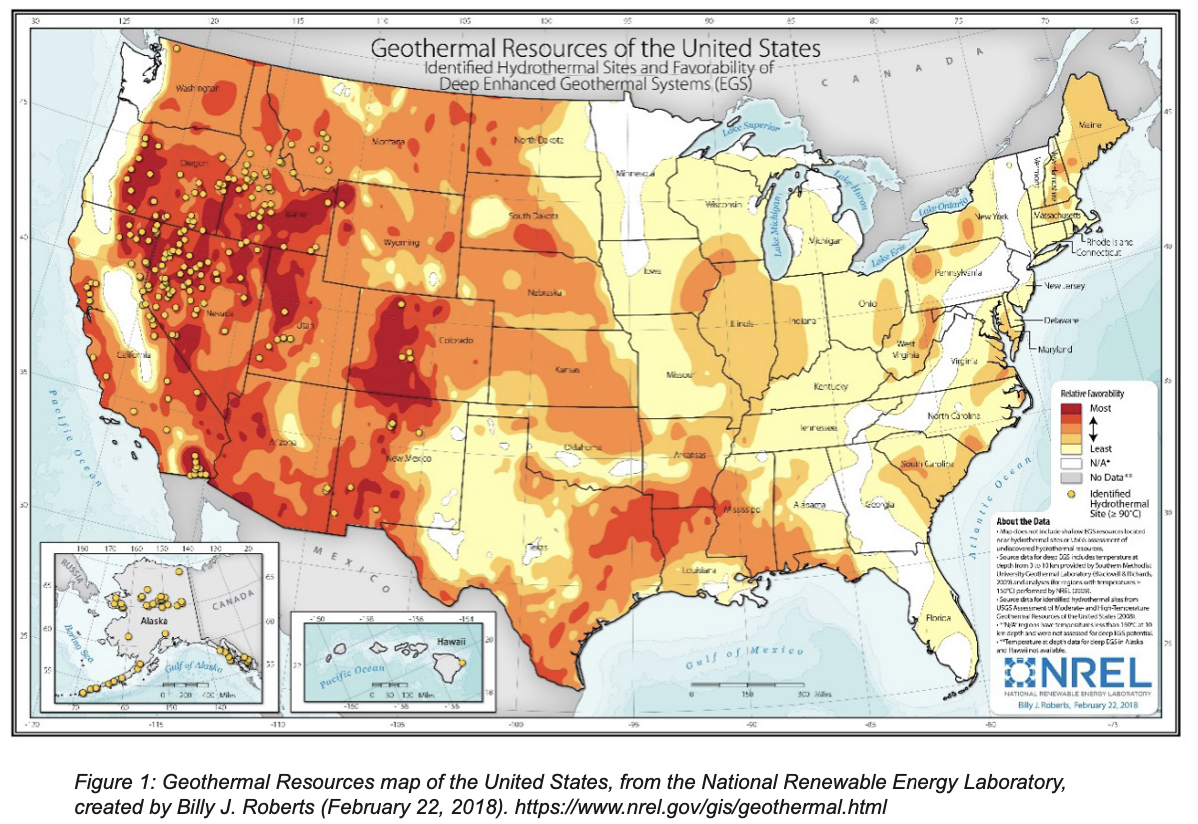Geothermal power has a range of applications, but it has limited usefulness as a utility-scale electric power source due to constrained suitable locations and potential pollution.
Read the original PDF, here.
Quick Bullets
- Because geothermal electric power generators require hot reservoirs to function, the viable sites for geothermal power plants are limited.
- Geothermal energy has the smallest land surface footprint of any renewable energy source, aside from nuclear power, and does not produce significant carbon dioxide emissions. [1]
- Geothermal power production has the potential to produce heavy metal contamination, which must be accounted for and mitigated.
Introduction
Geothermal energy comes from deep earth heat that remains from the formation of the planet, as well as ongoing radioactive decay inside the earth’s mantle. [2] The high temperatures form magma, which heats surrounding rock in the crust.
This natural heat of the earth is most easily available for use when it comes closer to the surface as hot springs, geysers, lava pits, underground hot water or steam reservoirs, and some high temperature dry rock reservoirs. [3] These conditions are most often found in tectonic plate boundary regions, like the Western United States, as seen in Figure 1 below, or in geologic “hot spots” of geothermal activity like Hawaii. [4] The limited number of locations for a geothermal power plant, along with transmission line construction in remote areas, are some of the major factors preventing more widespread adoption for electricity production.
How It Works
To produce power from a fluid-filled geothermal reservoir, a few conditions must exist: porosity, which allows a fluid to be collected in the rock; permeability, which allows the fluids to migrate throughout the rock; and the right temperature contained in the rock formation and associated fluids.
To begin with, a well is drilled to access the high temperature water or steam in a geothermal reservoir, then the fluid is piped to the surface, where it is used to turn a turbine and generate electricity. Geothermal energy can also be used to directly heat greenhouses, bodies of water, buildings, sidewalks, and other structures. [5]
Sometimes, if a hydrothermal reservoir does not have the right permeability conditions, fluid injection can open cracks in the rock to improve permeability, in a process that is very similar to hydraulic fracturing used in tight shale for natural gas production. [6]

Environment
Electricity generated by geothermal energy does not produce significant carbon dioxide emissions. However, drilling and circulating deep well water does emit some carbon dioxide and methane. It is also commonly produces hydrogen sulfide emissions, which can be dangerous to human and environmental health unless removed with scrubbers. [7]
Unless geothermal fluids produced are injected back into the reservoir, there may be an environmental threat from the heavy metals and other toxic elements that can come up with the produced water. These span the periodic table from mere salt to arsenic, boron, and mercury, among others. [8] If these materials are not managed, they can contaminate the soil and water.
Geothermal power plants take up less land than other renewable power sources. Because geothermal power is collected mainly in geologically active areas, such as tectonic plate boundaries, there is some evidence that the withdrawal and reinjection of steam or water can cause small tremors. [9]
Endnotes
[1] Alexander Richter, “Geothermal energy is least land-use intense source of the renewable energy technologies,” Think GeoEnergy, January 22, 2021, https://www.thinkgeoenergy.com/geothermal-energy-is-least-land-use-intense-source-ofthe-renewable-energy-technologies/
[2] Encyclopedia Britannica, “Geothermal energy,” Retrieved January 19, 2023, from https://www.britannica.com/science/ geothermal-energy
[3] Ibid.
[4] Robert Tilling et al., “Plate tectonics and the Hawaiian Hot Spot,” Geology.com, Retrieved January 19, 2023, from https://geology.com/usgs/hawaiian-hot-spot/
[5] U.S. Department of Energy, “Geothermal Technologies Program,” Retrieved January 19, 2023, from https://www.nrel.gov/docs/fy04osti/36316.pdf
[6] U.S. Department of Energy, “Enhanced Geothermal Systems,” Office of Energy Efficiency and Renewable Energy, Retrieved January 19, 2023, from https://www.energy.gov/eere/geothermal/enhanced-geothermal-systems
[7] Aras Karapekmez and Ibrahim Dincer, “Modelling of hydrogen production from hydrogen sulfide in geothermal power plants,” International Journal of Hydrogen Energy, Vol .43, Issue 23, pp. 10569–10579, June 2018, https://www.sciencedirect.com/science/article/abs/pii/S0360319918303987
[8] J.E. Sabadell & R.C. Axtmann, “Heavy metal contamination from geothermal sources,” Environmental Health Perspectives, Vol. 12, December 1975, pp. 1-7, https://www.ncbi.nlm.nih.gov/pmc/articles/PMC1475015/
[9] U.S. Geological Survey, “Why are there so many earthquakes in the Geysers area in Northern California?” Retrieved January 19, 2023, from https://www.usgs.gov/faqs/why-are-there-so-many-earthquakes-geysers-area-northern-california
Geothermal power has a range of applications, but it has limited usefulness as a utility-scale electric power source due to constrained suitable locations and potential pollution.
Read the original PDF, here.
Quick Bullets
- Because geothermal electric power generators require hot reservoirs to function, the viable sites for geothermal power plants are limited.
- Geothermal energy has the smallest land surface footprint of any renewable energy source, aside from nuclear power, and does not produce significant carbon dioxide emissions. [1]
- Geothermal power production has the potential to produce heavy metal contamination, which must be accounted for and mitigated.
Introduction
Geothermal energy comes from deep earth heat that remains from the formation of the planet, as well as ongoing radioactive decay inside the earth’s mantle. [2] The high temperatures form magma, which heats surrounding rock in the crust.
This natural heat of the earth is most easily available for use when it comes closer to the surface as hot springs, geysers, lava pits, underground hot water or steam reservoirs, and some high temperature dry rock reservoirs. [3] These conditions are most often found in tectonic plate boundary regions, like the Western United States, as seen in Figure 1 below, or in geologic “hot spots” of geothermal activity like Hawaii. [4] The limited number of locations for a geothermal power plant, along with transmission line construction in remote areas, are some of the major factors preventing more widespread adoption for electricity production.
How It Works
To produce power from a fluid-filled geothermal reservoir, a few conditions must exist: porosity, which allows a fluid to be collected in the rock; permeability, which allows the fluids to migrate throughout the rock; and the right temperature contained in the rock formation and associated fluids.
To begin with, a well is drilled to access the high temperature water or steam in a geothermal reservoir, then the fluid is piped to the surface, where it is used to turn a turbine and generate electricity. Geothermal energy can also be used to directly heat greenhouses, bodies of water, buildings, sidewalks, and other structures. [5]
Sometimes, if a hydrothermal reservoir does not have the right permeability conditions, fluid injection can open cracks in the rock to improve permeability, in a process that is very similar to hydraulic fracturing used in tight shale for natural gas production. [6]

Environment
Electricity generated by geothermal energy does not produce significant carbon dioxide emissions. However, drilling and circulating deep well water does emit some carbon dioxide and methane. It is also commonly produces hydrogen sulfide emissions, which can be dangerous to human and environmental health unless removed with scrubbers. [7]
Unless geothermal fluids produced are injected back into the reservoir, there may be an environmental threat from the heavy metals and other toxic elements that can come up with the produced water. These span the periodic table from mere salt to arsenic, boron, and mercury, among others. [8] If these materials are not managed, they can contaminate the soil and water.
Geothermal power plants take up less land than other renewable power sources. Because geothermal power is collected mainly in geologically active areas, such as tectonic plate boundaries, there is some evidence that the withdrawal and reinjection of steam or water can cause small tremors. [9]
Endnotes
[1] Alexander Richter, “Geothermal energy is least land-use intense source of the renewable energy technologies,” Think GeoEnergy, January 22, 2021, https://www.thinkgeoenergy.com/geothermal-energy-is-least-land-use-intense-source-ofthe-renewable-energy-technologies/
[2] Encyclopedia Britannica, “Geothermal energy,” Retrieved January 19, 2023, from https://www.britannica.com/science/ geothermal-energy
[3] Ibid.
[4] Robert Tilling et al., “Plate tectonics and the Hawaiian Hot Spot,” Geology.com, Retrieved January 19, 2023, from https://geology.com/usgs/hawaiian-hot-spot/
[5] U.S. Department of Energy, “Geothermal Technologies Program,” Retrieved January 19, 2023, from https://www.nrel.gov/docs/fy04osti/36316.pdf
[6] U.S. Department of Energy, “Enhanced Geothermal Systems,” Office of Energy Efficiency and Renewable Energy, Retrieved January 19, 2023, from https://www.energy.gov/eere/geothermal/enhanced-geothermal-systems
[7] Aras Karapekmez and Ibrahim Dincer, “Modelling of hydrogen production from hydrogen sulfide in geothermal power plants,” International Journal of Hydrogen Energy, Vol .43, Issue 23, pp. 10569–10579, June 2018, https://www.sciencedirect.com/science/article/abs/pii/S0360319918303987
[8] J.E. Sabadell & R.C. Axtmann, “Heavy metal contamination from geothermal sources,” Environmental Health Perspectives, Vol. 12, December 1975, pp. 1-7, https://www.ncbi.nlm.nih.gov/pmc/articles/PMC1475015/
[9] U.S. Geological Survey, “Why are there so many earthquakes in the Geysers area in Northern California?” Retrieved January 19, 2023, from https://www.usgs.gov/faqs/why-are-there-so-many-earthquakes-geysers-area-northern-california


